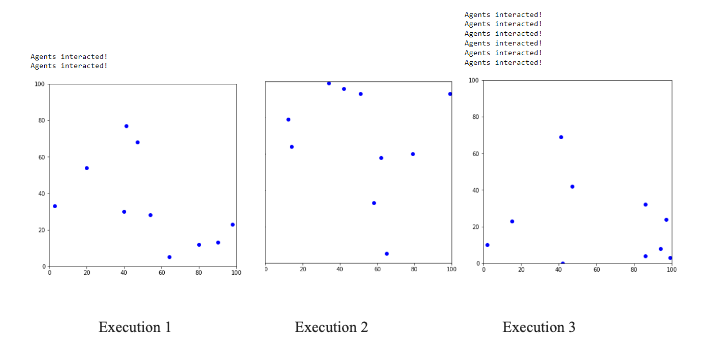Agent-based modeling (ABM) is a computational modeling technique that has a variety of different applications across many disciplines, including economics, social sciences, ecology and engineering. ABM is a bottom-up method that mimics individual agent behavior and how they interact with the environment to comprehend system behavior overall.
Agent-Based Modeling Explained
Agent-based modeling is a computational modeling technique that uses a bottom-up method to mimic how an individual agent interacts with the environment to better understand the system’s overall behavior. It’s used in economics, social sciences, ecology, engineering and more.
Agents are autonomous entities in an ABM with distinct traits, behaviors and rules for making decisions. These agents function inside their immediate surroundings, i.e. their environment. These agents can communicate with one another as well as with their surroundings. The behaviors of other agents in the vicinity and the environment in which an agent functions can have an impact on the decisions and actions of the agent. Algorithms, rules and mathematical formulas are used to model agent-environment interactions.
Types of Agent-Based Models
Agent based models have many different types based on their application and use.
1. Social Agent-Based Models
These models simulate how individuals would act in social environments such as families, offices and societies. They are used in the investigation of social phenomena, including opinion formation, cultural shift and social network dynamics.
2. Ecological Agent-Based Models
These models study ecological phenomena such as species interactions, population dynamics and ecosystem resilience by simulating the behavior of individual animals in ecosystems.
3. Economic Agent-Based Models
These models are used to research economic phenomena such as market dynamics, wealth distribution and the effects of economic policies by simulating the behavior of economic agents such as consumers, suppliers and governments.
4. Organizational Agent-Based Models
These models mimic the actions of agents within organizations to investigate organizational phenomena such as organizational structure, resource distribution and decision-making procedures.
5. Multi-Agent Systems (MAS)
These agent-based models can include all the previously mentioned kinds. MAS is a more general category. They are employed in the study of intricate systems including supply chains, robotic swarms and traffic networks where numerous actors cooperate to accomplish their separate objectives.
Agent-Based Modeling Example With Code
Below is a Python example demonstrating the principles of agent-based modeling. This code demonstrates an agent-based model that incorporates agent-agent interactions within the grid, i.e. their environment and the agent-environment interactions.
The Agent class represents individual agents with their own positions within the grid. The move method allows agents to move randomly within the grid within the bounds that simulate agent-environment interaction. The interact method checks if two agents occupy the same position, simulating an interaction between them. The code creates a specified number of agents with random initial positions and simulates their movement and interactions for a specified number of steps. Finally, the code visualizes the agent positions using Matplotlib.
import matplotlib.pyplot as plt
import random
class Agent:
def __init__(self, x, y):
self.x = x
self.y = y
def move(self, grid_size):
dx = random.randint(-1, 1)
dy = random.randint(-1, 1)
new_x = self.x + dx
new_y = self.y + dy
if 0 <= new_x < grid_size and 0 <= new_y < grid_size:
self.x = new_x
self.y = new_y
def interact(self, other_agent):
if self.x == other_agent.x and self.y == other_agent.y:
print("Agents interacted!")
# Create agents
num_agents = 10
grid_size = 100
agents = [Agent(random.randint(0, grid_size-1), random.randint(0, grid_size-1)) for _ in range(num_agents)]This code exemplifies key principles of agent-based modeling, including the representation of autonomous agents with their own behaviors and rules, the interaction between agents, and the observation of emergent patterns and behaviors. The conclusions that can be drawn include the exploration and dispersion of agents within the grid, the avoidance of collisions with the grid boundaries, and the potential for interactions between agents when they occupy the same position.
# Simulate movement and interaction
num_steps = 100
for _ in range(num_steps):
for agent in agents:
agent.move(grid_size)
for other_agent in agents:
if agent != other_agent:
agent.interact(other_agent)
# Plot agent positions
plt.figure(figsize=(6, 6))
plt.xlim(0, grid_size)
plt.ylim(0, grid_size)
for agent in agents:
plt.scatter(agent.x, agent.y, color='blue')
plt.show()
These conclusions highlight the impact of agent-agent and agent-environment interactions on the overall system dynamics and provide insights into the emergent behavior that arises from the local interactions of individual agents.
Agent Based Modeling Techniques to Know
Agent-based modeling is an umbrella term for a variety of complex system modeling techniques.
1. Rule-Based Modeling
This is a kind of ABM that involves predefining a set of rules that dictate the behavior and interactions of agents with the environment and other agents. There may be applications of both deterministic and probabilistic laws.
2. Learning Algorithms
This technique is where agents in the ABM utilize learning algorithms, like reinforcement learning or machine learning, to adapt their behavior based on past interactions or encounters.
3. Network Modeling Agents
In network modeling, agents are represented as nodes in a network, while relationships or interactions between agents are indicated by edges. One common application for this technique is modeling communication and social networks.
4. Spatial Agent-Based Modeling
This involves placing agents within a spatial environment and adjusting their interactions based on their locations. It’s commonly applied in the modeling of ecological systems and urban dynamics.
5. Cellular Automata Technique
Another one is the cellular automata technique, in which agents are arranged in a grid where each cell can only exist in a limited number of states. The behavior of each cell over time is determined by the states of its neighboring cells and a set of predefined rules. This method is often used to simulate physical or biological systems.
6. Agent-Based Simulation Models
These focus on simulating the interactions between individual agents and their environment, as well as tracking each agent’s path through the simulation. This approach is frequently employed to study emergent phenomena in complex systems.
Hybrid models combine various modeling techniques to create more comprehensive models that capture different aspects of a complex system. For instance, integrating agent-based modeling with system dynamics modeling allows for the study of interactions between individual behaviors and system-level dynamics.
Benefits and Limitations of Agent Based Modeling
Agent-based models have many advantages. ABM is good at capturing complex patterns and behaviors that come up from the interactions between individual agents. Unlike the usual modeling methods, ABM lets us see and analyze how local interactions among agents can lead to unexpected and often really intricate global patterns. This makes it super useful for studying systems like social networks, ecosystems and marketplaces, where the overall behavior is way more complex than just the sum of its parts.
ABM provides a more natural and intuitive way to model complex systems. By modeling individual agents and their interactions, it closely aligns with how real-world systems work. Each agent can be programmed with rules and behaviors that imitate real-life entities, making the model more relatable and easier to understand. This approach centered around agents allows researchers and stakeholders to visualize and understand the system’s dynamics more effectively.
ABM’s adaptability is one of its main advantages. By changing the number and the type of agents, their actions, and the rules controlling their interactions, an agent-based model can be made as simple or complex as required. Because they can be scaled, models can begin simple and become more complicated as new data becomes available or as the questions guiding the research change. ABM can be applied to a wide range of tasks, from straightforward theoretical investigations to intricate, data-driven models of actual phenomena.
However, ABM has limitations as well. One challenge is computational complexity, particularly with large numbers of agents or complex interactions. It can strain computational resources. Validating and calibrating ABMs can be difficult due to the emergent behavior that arises from simple agent rules. Determining appropriate parameter values is another challenge, as a small change can lead to significantly different outcomes. Additionally, interpreting ABM results can be complex, requiring detailed analysis to understand how individual behaviors contribute to overall system dynamics. ABMs can also require extensive data collection and processing.
Applications of Agent Based Modeling
ABM is used to explore the emergent features of complex systems by simulating them, including social networks, financial markets and ecosystems. It enables researchers to investigate many scenarios and test various theories in a controlled setting that they can alter, which can be helpful in forecasting how real-world systems would behave and formulating plans to enhance their functionality.
An example of a real-world application is the simulation of city traffic flow. According to this concept, every vehicle is an agent with distinct properties like speed, direction and destination. The agents obey traffic signals, keep a safe distance from other cars and respect speed limits as they interact with one another and their surroundings. Adding a new road or changing traffic patterns are two examples of the scenarios that may be simulated using this model. Researchers can investigate how systemic changes impact traffic flow, congestion and safety by modifying the model’s parameters and regulations.
Another example of agent-based modeling is the simulation of disease propagation within a population. Every person in this model is an agent with unique attributes, including age, health and social network. The agents follow social distancing, mask-wearing and seek medical attention when needed as they interact with the environment and each other. The model can be used to simulate a variety of situations, including the release of a new vaccination or modifications to public health regulations. Researchers can investigate how systemic changes impact the spread of the disease and the efficacy of various interventions by modifying the model’s parameters and regulations.
Frequently Asked Questions
What is agent-based modeling?
Agent-based modeling (ABM) is a methodology used to build formal models of real-world systems that are made up of individual units or agents, that interact with each other and their environment.
What are the different types of agent-based models?
There are many different types of agent-based models that depend on the application and objective of the model. Examples include:
- Social agent-based model.
- Ecological agent-based model
- Economic agent-based model
- Organizational agent-based model
- Multi-agent systems





